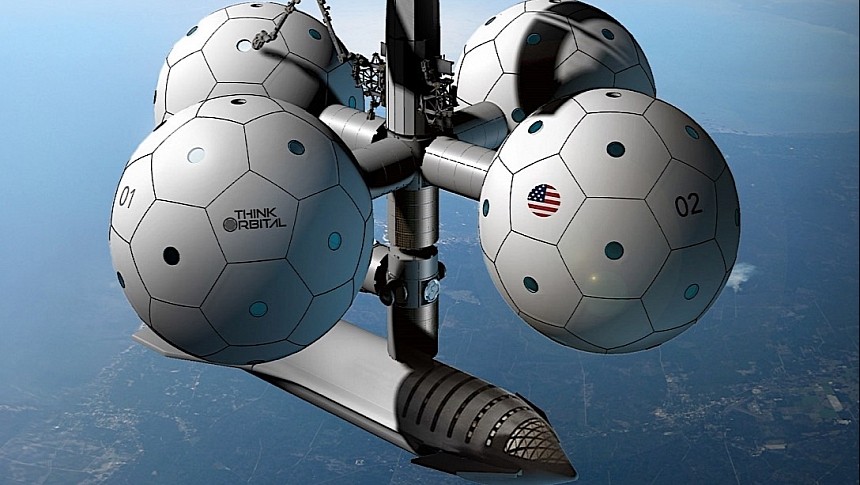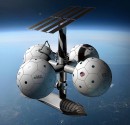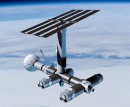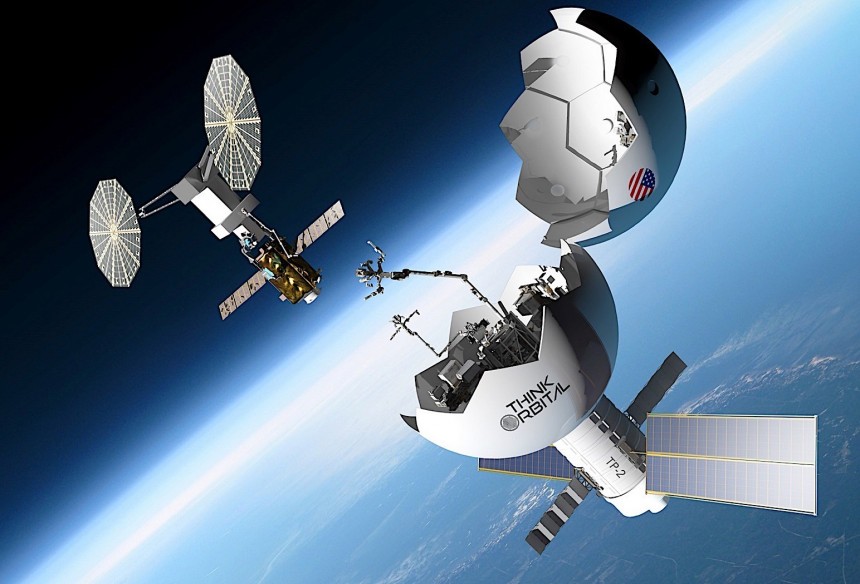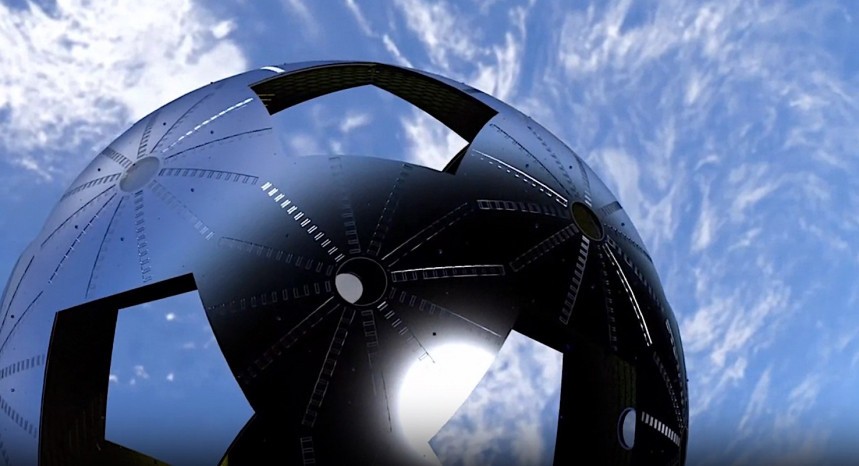Our generation has the fortune of living through perhaps the most exciting times for space exploration. For the first time in history, our species is not only eyeing short trips to the immediate neighborhood, but it is actively planning to colonize Earth's low orbit, and ever places further out, like the Moon and Mars.
Because of this renewed enthusiasm, fueled not in small part by private space companies that spawned by the dozens in recent years, space exploration is enjoying its sweet time under the spotlight. But only a small part of it, if you really think about it, the one that has to do with incredible spaceships and daring astronauts.
For our species to become truly expansive, we of course need a lot more than that. If we are really to spread throughout the solar system and beyond, we need to learn to assemble and repair spaceships, space stations and other gear away from the confines of this planet. We need, in essence, orbital shipyards and cities.
We're probably still a long way from such a thing, but the first steps in making that dream a reality are taken as you're reading this. NASA calls this approach In-Space Servicing, Assembly, and Manufacturing (ISAM), and it's a task only a handful of companies have taken on. Among them is a group called ThinkOrbital, whose stated mission is as simple as it is daring: build space.
The way the company plans to do that is through something it describes as a "cost-effective, pressurizable, scalable and multi-purpose infrastructure" called ThinkPlatform. We're in essence talking about a space station, but not shaped in a cylindrical way like current designs are, but as a sphere.
This shape was chosen by the company because it can provide a large space volume but also allow for optimal defense against debris and thermal effects. And probably aesthetic reasoning was part of the decision, as you have to admit, this thing is a lot easier on the eye than the current International Space Station.
Depending on what it is supposed to do, the ThinkPlatform can come in one of four dimensions and configurations.
First up is the ThinkPlatform-1. The smallest of the bunch, it's meant to be attached to an existing space station and be used for anything from storage, including fuel, to an entertainment room – I mean, it's easy to imagine the sphere equipped with large screens to reveal vistas of space and Earth, or play a movie, or whatever. The module in this configuration is 8.5 meters (28 feet) in diameter and has an interior volume of 300 cubic meters.
Second in line is the ThinkPlatform-2, meant for on-orbit servicing, assembly and manufacturing. Coming in at 20 meters (66 feet) in diameter and with 4,000 cubic meters of interior volume. This one is free-flying, meaning it doesn't need to be attached to an existing structure and, most importantly, it is not pressurized. That’s because it's not meant to house humans but gear for servicing, refueling, and manufacturing.
This one could be equipped with maneuvering arms that can be used for self-assembly and are to carry an electron beam welding gun for the operations it needs to perform up there. Other tools are also likely, but no mention of them has been made yet.
Up next is, you guessed it, the ThinkPlatform-3. This one is a mammoth, even by today's standards, as it's supposed to have four times the volume of the current ISS: 20 meters in diameter and 4,000 cubic meters in volume. I know, you'll tell me those as the same numbers as the previous ThinkPlatform, but keep in mind that one is meant only for logistic services, whereas this one is pressurized and capable of supporting up to 40 people. The company envisions this design as perfect for either space tourism or research.
Last but not least comes the ThinkPlatform-4, which is nothing more than a number of any of the previous ones linked together. Officially called a connected sphere cluster, the design probably has few limits in terms of how large it can grow and has the potential to keep alive within its footballs possibly hundreds of people – a true orbital city from the early days of space exploration.
It's not exactly clear how far along the company is in developing the ThinkPlatforms, or when we should expect the first tangible results. NASA itself seems to be fairly confident about the idea of these football-shaped space habitats, and as recently as this month included ThinkOrbital on the list of companies it believes could help it advance its goals.
More to the point, ThinkOrbital is one of seven companies, alongside Blue Origin, Northrop Grumman, Sierra Space, SpaceX, Special Aerospace Services, and Vast, chosen as part of the Collaborations for Commercial Space Capabilities-2 (CCSC-2) program.
No exact details of the company's participation in the project were announced, but it is obvious NASA is targeting the tech described above, as it will open up new possibilities for space exploration.
Of all the space projects going on at the moment, I find this one to be one of the most exciting, and the one that, if successful, will really open the doors to a true space-faring civilization.
For our species to become truly expansive, we of course need a lot more than that. If we are really to spread throughout the solar system and beyond, we need to learn to assemble and repair spaceships, space stations and other gear away from the confines of this planet. We need, in essence, orbital shipyards and cities.
We're probably still a long way from such a thing, but the first steps in making that dream a reality are taken as you're reading this. NASA calls this approach In-Space Servicing, Assembly, and Manufacturing (ISAM), and it's a task only a handful of companies have taken on. Among them is a group called ThinkOrbital, whose stated mission is as simple as it is daring: build space.
The way the company plans to do that is through something it describes as a "cost-effective, pressurizable, scalable and multi-purpose infrastructure" called ThinkPlatform. We're in essence talking about a space station, but not shaped in a cylindrical way like current designs are, but as a sphere.
This shape was chosen by the company because it can provide a large space volume but also allow for optimal defense against debris and thermal effects. And probably aesthetic reasoning was part of the decision, as you have to admit, this thing is a lot easier on the eye than the current International Space Station.
First up is the ThinkPlatform-1. The smallest of the bunch, it's meant to be attached to an existing space station and be used for anything from storage, including fuel, to an entertainment room – I mean, it's easy to imagine the sphere equipped with large screens to reveal vistas of space and Earth, or play a movie, or whatever. The module in this configuration is 8.5 meters (28 feet) in diameter and has an interior volume of 300 cubic meters.
Second in line is the ThinkPlatform-2, meant for on-orbit servicing, assembly and manufacturing. Coming in at 20 meters (66 feet) in diameter and with 4,000 cubic meters of interior volume. This one is free-flying, meaning it doesn't need to be attached to an existing structure and, most importantly, it is not pressurized. That’s because it's not meant to house humans but gear for servicing, refueling, and manufacturing.
This one could be equipped with maneuvering arms that can be used for self-assembly and are to carry an electron beam welding gun for the operations it needs to perform up there. Other tools are also likely, but no mention of them has been made yet.
Up next is, you guessed it, the ThinkPlatform-3. This one is a mammoth, even by today's standards, as it's supposed to have four times the volume of the current ISS: 20 meters in diameter and 4,000 cubic meters in volume. I know, you'll tell me those as the same numbers as the previous ThinkPlatform, but keep in mind that one is meant only for logistic services, whereas this one is pressurized and capable of supporting up to 40 people. The company envisions this design as perfect for either space tourism or research.
It's not exactly clear how far along the company is in developing the ThinkPlatforms, or when we should expect the first tangible results. NASA itself seems to be fairly confident about the idea of these football-shaped space habitats, and as recently as this month included ThinkOrbital on the list of companies it believes could help it advance its goals.
More to the point, ThinkOrbital is one of seven companies, alongside Blue Origin, Northrop Grumman, Sierra Space, SpaceX, Special Aerospace Services, and Vast, chosen as part of the Collaborations for Commercial Space Capabilities-2 (CCSC-2) program.
No exact details of the company's participation in the project were announced, but it is obvious NASA is targeting the tech described above, as it will open up new possibilities for space exploration.
Of all the space projects going on at the moment, I find this one to be one of the most exciting, and the one that, if successful, will really open the doors to a true space-faring civilization.
